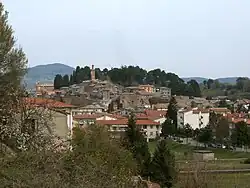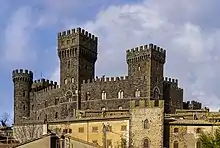Acquapendente
Acquapendente is a city and comune in the province of Viterbo, in Lazio (Italy). Acquapendente is a centre for the agricultural production of vegetables and wine, and has a tradition of pottery craftsmanship. Its frazione of Torre Alfina is a member of the I Borghi più belli d'Italia ("The most beautiful villages of Italy") association.[3]
Acquapendente | |
|---|---|
| Comune di Acquapendente | |
 | |
.svg.png.webp) Acquapendente within the Province of Viterbo | |
Location of Acquapendente | |
 Acquapendente Location of Acquapendente in Italy  Acquapendente Acquapendente (Lazio) | |
| Coordinates: 42°44′38″N 11°51′52″E | |
| Country | Italy |
| Region | Lazio |
| Province | Viterbo (VT) |
| Frazioni | Torre Alfina, Trevinano |
| Government | |
| • Mayor | Angelo Ghinassi |
| Area | |
| • Total | 131.61 km2 (50.81 sq mi) |
| Elevation | 420 m (1,380 ft) |
| Population (30 April 2017)[2] | |
| • Total | 5,428 |
| • Density | 41/km2 (110/sq mi) |
| Demonym | Aquesiani |
| Time zone | UTC+1 (CET) |
| • Summer (DST) | UTC+2 (CEST) |
| Postal code | 01021 |
| Dialing code | 0763 |
| Patron saint | Saint Hermes |
| Saint day | August 28 |
| Website | Official website |
History
The area of modern Acquapendente was settled by Etruscans in Roman times, as archaeological finds have shown.[4] However, the first historical document of the modern city dates from the 9th century AD, with a town named Farisa or Arisa along the Via Francigena. A document from Emperor Otto I, dated 964, contains the first recorded use of the name Acquapendentem which means "hanging water", from several small waterfalls in the Paglia river on the boundary between Lazio and Tuscany.

Acquapendente was the first stop in Italy in the travels of Saint Roch in the early 14th century; the saint supposedly spent several days in the hospital there curing plague victims.[5]
The city was later part of the March of Tuscany and, from the end of the 14th century and beginning of the 15th, it was part of the commune (later Republic) of Siena. In 1449 it became an independent centre within the Papal States.
After the complete destruction of Castro, Lazio in 1649, Acquapendente, previously part of the diocese of Orvieto, became the seat of a diocese that included what had been the diocese of Castro.[6][7][8] The diocese of Acquapendente continued in existence until 27 March 1986, when its territory was added to that of Viterbo.[9] No longer a residential bishopric, Aquipendium, as it is called in Latin, is today listed by the Catholic Church as a titular see.[10]
Geography
Located in the north of the Lazio, near the borders with Tuscany and Umbria, the municipality of Acquapendente borders with Allerona (TR), Castel Giorgio (TR), Castel Viscardo (TR), Grotte di Castro, Onano, Proceno, San Lorenzo Nuovo, San Casciano dei Bagni (SI) and Sorano (GR).
Main sights
- Acquapendente Cathedral (1149)
- The Watch Tower, remains of the Imperial Castle
- The church of St. Augustine (16th century)
- The church of St. Francis
- The castle of the frazione Torre Alfina, whose central tower (Italian: cassero) was built by the Lombard king Desiderius. The castle was captured by the Neapolitan condottiero Fabrizio Maramaldo during the 1527 Siege of Rome, but the defenders gallantly retained the Cassero.
- The castle of the frazione Trevinano known from the 12th century.
- The Monte Rufeno Natural Reserve, 2 kilometres (1.2 mi) north of the city, at an elevation of 748 metres (2,454 ft). It has spectacular woods housing wildlife including, among others, wild boars, Eurasian eagle-owls, turtles and beech martens.
- A POW camp from World War II
Personalities
- Hieronymus Fabricius (1537–1619), anatomist and surgeon
References
- "Superficie di Comuni Province e Regioni italiane al 9 ottobre 2011". Italian National Institute of Statistics. Retrieved 16 March 2019.
- Population data from Istat
- "Lazio" (in Italian). Retrieved 1 August 2023.
- "History at the Acquapendente communal website". Archived from the original on 2013-06-21. Retrieved 2013-07-02.
- Francesco Diedo, Vita Sancti Rochi (1478), translated by Irene Vaslef, in Irene Vaslef, "The Role of St. Roch as a Plague Saint: A Medieval Hagiographic Tradition" (PhD diss., Catholic University, 1984), 198.
- Giuseppe Cappelletti, Le Chiese d'Italia dalla loro origine sino ai nostri giorni, Venezia 1846, vol. V, pp. 549-581
- Pius Bonifacius Gams, Series episcoporum Ecclesiae Catholicae, Leipzig 1931, pp. 659-660
- Konrad Eubel, Hierarchia Catholica Medii Aevi, vol. 1 Archived 2019-07-09 at the Wayback Machine, pp. 173-174; vol. 2 Archived 2018-10-04 at the Wayback Machine, pp. XIX, 121; vol. 3 Archived 2019-03-21 at the Wayback Machine, p. 157; vol. 4 Archived 2018-10-04 at the Wayback Machine, p. 140
- Bull Qui non sine Archived April 8, 2014, at the Wayback Machine
- Annuario Pontificio 2013 (Libreria Editrice Vaticana 2013 ISBN 978-88-209-9070-1), p. 823
External links
![]() Media related to Acquapendente at Wikimedia Commons
Media related to Acquapendente at Wikimedia Commons
- Sagra della Fregnaccia in Acquapendente at Discover Soriano
- Official website
- Tourism page (in Italian)
- Monte Rufeno Natural Reserve
- Tuscia 360 about Acquapendente with VR panoramas of Pugnaloni
- Acquapendente pro loco association (in Italian)